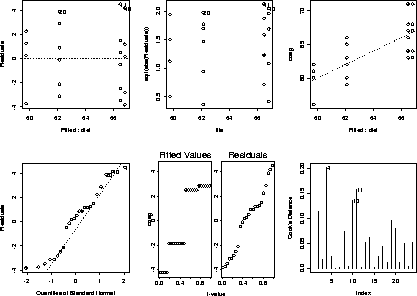
The following data is from Box, Hunter and Hunter (1978) and is also analyzed in Chapter 13 of the SPLUS Guide to Statistics. It gives blood coagulation times for each of four diets.
We enter the data more or less as in the SPLUS manual,
402 > coag.times _ scan()
1: 62 63 68 56
5: 60 67 66 62
9: 63 71 71 60
13: 59 64 67 61
17: 65 68 63
20: 66 68 64
23: 63
24: 59
25:
402 > diet _ factor(c(rep(LETTERS[1:4],4),rep(LETTERS[1:3],2),c("A","A")))
402 > split(coag.times,diet) # check that the factor labels are right
$A: [1] 62 60 63 59 65 66 63 59
$B: [1] 63 67 71 64 68 68
$C: [1] 68 66 71 67 63 64
$D: [1] 56 62 60 61
402 > sapply(split(coag.times,diet),mean)
A B C D
62.125 66.83333 66.5 59.75
402 > coag _ data.frame(coag=coag.times,diet=diet)
Now we fit the model, look at some diagnostic plots, and consider the analysis of variance table. More details on the SPLUS parts of the problem can be found in Chapter 13 of the SPLUS Guide to Statistics.
402 > coag.aov _ aov(coag ~ diet, data=coag) 402 > par(mfrow=c(2,3)) 402 > plot(coag.aov)

402 > model.tables(coag.aov,type="means")
Refitting model to allow projection
Tables of means
Grand mean
64
diet
A B C D
62.12 66.83 66.5 59.75
rep 8.00 6.00 6.0 4.00
The cell means  and the grand mean
and the grand mean  are illustrated in
the figure below; the cell means
are illustrated in
the figure below; the cell means  are the estimates of
the
are the estimates of
the  's in the cell means model
's in the cell means model

where k is the number of cells, and there are  observations in
the
observations in
the  cell. As usual in regression, the error terms
(
cell. As usual in regression, the error terms
( in this case) are distributed
in this case) are distributed  for
some unknown error variance
for
some unknown error variance  .
.
=1in

Now recall that we can write the deviation of a single observation from the grand mean as

If we square and sum these terms, the magic of orthogonal sums of squares tells us

with degrees of freedom n-1, n-k and k-1 respectively. This gives rise to the ANOVA table

Here is SPLUS's ANOVA table for this ANOVA model.
402 > anova(coag.aov) # some output omitted below
Terms added sequentially (first to last)
Df Sum of Sq Mean Sq F Value Pr(F)
diet 3 186.0417 62.01389 8.055931 0.001028171
Residuals 20 153.9583 7.69792
402 > 186.0417 /( 186.0417 +153.9583) # R^2
[1] 0.5471815
The F statistic for testing whether the factor explains the variation
in Y is

Under the null hypothesis

 is distributed as
is distributed as  . Large values of
. Large values of  argue in
favor of
argue in
favor of
